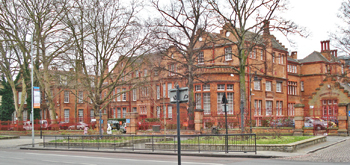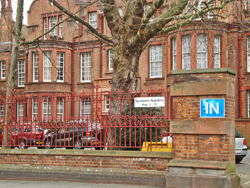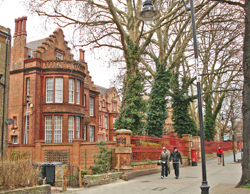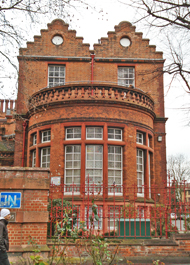Jewish Home
and Hospital for
Incurables
295 High Road, South Tottenham, N15 4RT
Medical
dates:
Medical
character:
Long-term care
Originally founded in 1889 at
Nos. 49-51 Victoria Park Road in Hackney, the Home for Jewish
incurables offered care to poor Jewish immigrants permanently disabled
by chronic disease, accident or physical handicap. It had 9
inmates.
In 1896 the Board of Management purchased 4 acres of land in Tottenham High Road in order to build a new Home. The premises at Victoria Park Road had become unsuitable by then and, in 1898, the patients were removed to Berthons, an aging mansion in Wood Street, Walthamstow, near Whipps Cross. The lease of the old property was sold.
The new building was completed in 1903 and was formally opened by Princess Louise, Duchess of Argyll, on 3rd July. It had 80 beds - men on the ground floor and women on the floor above. The new Home contained a concert hall.
The Home was extended in 1913, when a new wing with 34 beds was added, and a synagogue designed by Marcus Collins, who had also designed the Home, opened in 1914 (it was consecrated at the end of WW1).
In 1918, at the end of the war, the Ministry of Pensions requested that the new wing be used to accommodate incurable Jewish ex-servicemen. The Board of Management agreed to admit 28 such patients for twelve months.
A Nurses' Home was built in 1938.
In 1939, at the outbreak of WW2, because of the fear of air raids, the Home was evacuated to Chesterfield House, near Saffron Walden. The vacant accommodation was taken over in May 1940 by the Middlesex County Council and used to house refugees.
In 1947 the Hospital was informed that it would be nationalised under the NHS Act (1946), along with the Royal Hospital and Home for Incurables in Putney and the British Home and Hospital for Incurables in Streatham. All three homes appealed against this on the grounds that they would be able to provide more specific care to their patients, focussed on long-term needs. In 1950 the Ministry of Health withdrew its claims and all three remained independent.
A new block was added in 1964 and, by 1972, the Home had 114 patients.
In 1992 it merged with Jewish Care.
By the late 20th century Tottenham's Jewish population had largely moved away and the building became obsolete.
The Home closed in 1995.
In 1896 the Board of Management purchased 4 acres of land in Tottenham High Road in order to build a new Home. The premises at Victoria Park Road had become unsuitable by then and, in 1898, the patients were removed to Berthons, an aging mansion in Wood Street, Walthamstow, near Whipps Cross. The lease of the old property was sold.
The new building was completed in 1903 and was formally opened by Princess Louise, Duchess of Argyll, on 3rd July. It had 80 beds - men on the ground floor and women on the floor above. The new Home contained a concert hall.
The Home was extended in 1913, when a new wing with 34 beds was added, and a synagogue designed by Marcus Collins, who had also designed the Home, opened in 1914 (it was consecrated at the end of WW1).
In 1918, at the end of the war, the Ministry of Pensions requested that the new wing be used to accommodate incurable Jewish ex-servicemen. The Board of Management agreed to admit 28 such patients for twelve months.
A Nurses' Home was built in 1938.
In 1939, at the outbreak of WW2, because of the fear of air raids, the Home was evacuated to Chesterfield House, near Saffron Walden. The vacant accommodation was taken over in May 1940 by the Middlesex County Council and used to house refugees.
In 1947 the Hospital was informed that it would be nationalised under the NHS Act (1946), along with the Royal Hospital and Home for Incurables in Putney and the British Home and Hospital for Incurables in Streatham. All three homes appealed against this on the grounds that they would be able to provide more specific care to their patients, focussed on long-term needs. In 1950 the Ministry of Health withdrew its claims and all three remained independent.
A new block was added in 1964 and, by 1972, the Home had 114 patients.
In 1992 it merged with Jewish Care.
By the late 20th century Tottenham's Jewish population had largely moved away and the building became obsolete.
The Home closed in 1995.
Present status (February
2008)
When the Home closed some of the fittings of the synagogue, including the Ark, were removed to the Sukkat Shalom Reform Synagogue in Wanstead.
The 'John Thomas chimney piece' was offered for sale recently (February 2008) by the auctioneering firm Lassco.
The listed building on a 2-acre site was redeveloped for 79 units of social housing by Circle 33 (now Circle Anglia). It is now Sycamore Gardens. The original spearhead railings remain.
When the Home closed some of the fittings of the synagogue, including the Ark, were removed to the Sukkat Shalom Reform Synagogue in Wanstead.
The 'John Thomas chimney piece' was offered for sale recently (February 2008) by the auctioneering firm Lassco.
The listed building on a 2-acre site was redeveloped for 79 units of social housing by Circle 33 (now Circle Anglia). It is now Sycamore Gardens. The original spearhead railings remain.

The buildings from across the High Road.

The former main entrance. Note the original railings.

The north end. The small building on the right, which is now the tenants' hall, could have been the mortuary once.

The frontage along the High Road, seen from the south.

The southern elevation.

The north wing.
Cook GC 2004 Caring for "incurables": the 150th anniversary of the Royal Hospital for Neuro-Disability, Putney. Postgraduate Medical Journal 80, 426-430.
www.british-history.ac.uk
www.flickr.com (1)
www.flickr.com (2)
www.southampton.ac.uk
Return to home page